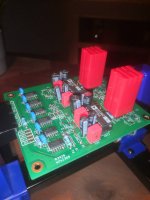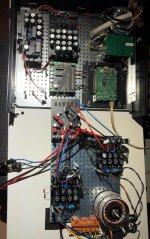C31 and C36 are SMD MLCC. not sure SMD exists in polystyrene type 😀
are C31 and C36 cap vital to sound quality?
any suggestion for this 47p cap?
I found lots of place, but just can't find polystyrene cap with 47p value
Thanks
> are C31 and C36 cap vital to sound quality?
Yes.
> any suggestion for this 47p cap?
Fidelity-Audio
Plenty other google hits.
> C31 and C36 are SMD
Easy enough to solder a Styroflex in parallel with R8, R9 on the bottom side.
Cheers,
Patrick
Yes.
> any suggestion for this 47p cap?
Fidelity-Audio
Plenty other google hits.
> C31 and C36 are SMD
Easy enough to solder a Styroflex in parallel with R8, R9 on the bottom side.
Cheers,
Patrick
it has ... it may be omitted
otherwise use MLCC (C0G or NP0)
80-C1206C470JDGAUTO
or foil:
505-FKP2O100471D00JF
otherwise use MLCC (C0G or NP0)
80-C1206C470JDGAUTO
or foil:
505-FKP2O100471D00JF
Hi Miro,
AD1862 dac from KuSy looks like yours...do you know the guys behind?
I do not know them. It is different design. Direct input and unknown output 🙂
Just a heads up for beginners, because video that miro posted is a bit misleading 🙂. On video they cheated (see pins on the left and right side) Most important step is to fix the chip to pcb with third arm or some other creative solutions 😀 because SMD parts can float in flux all over the pcb 😀 And don't ask how I know 😀
I did that "dragging" with my muses volume control, however these SO14 chips were a little bigger so decided to solder them leg by leg. Proved to be more work in the end. I like the dragging technique very much except for the fact that my flux is really sticky and hard to remove, even with isopropanol.
My ali china psu's arrived (as a test if they are any good,both 12 and 5v are lm317/lm337).
Exciting! 🙂
I turned on my dac today and put 680ohm iv resistors and do not put the caps... so far it sounds good.. [emoji6]it has ... it may be omitted
otherwise use MLCC (C0G or NP0)
80-C1206C470JDGAUTO
or foil:
505-FKP2O100471D00JF
Last edited:
...
My ali china psu's arrived (as a test if they are any good,both 12 and 5v are lm317/lm337).
Exciting! 🙂
Perfect! Tell us more after an intensive testing. You can also add a few pictures 😉
I'm only able to present some preliminary findings as it's open bench (with temp sensitive reg's) and China-based AD1862's (the ones from Paddy are on their way).
w/o burn-in & LM6171 the sound is really promising!
The current draw is quite low - I expected higher values. I measured around 18,6 mA (A+), 25,9 mA (A-), 6,3mA (D+) and 3,4 mA (D-) when playing. With ~ 110uF decoupling peaks are ~ +/- 1,5 mA in the analog section. But I think my Fluke 289 isn't fast enough to catch the spikes.
The build/testing will slow down from now on. I have to wait for the new RPi/FifoPi mounting pcb and the genuine AD1862 from Paddy. Also I noticed yesterday that the smd-adaptors I have lying around can't be safely used with 49990 due to the bottom pad. In addition I'm somewhat fixed on trying out the discrete I/V from EUVL. But I have to design a pcb first and get some parts - it never stops ...
I have OPA1656, OPA1611, OPA810, OPA861 at home - any recommendations what to try next?
w/o burn-in & LM6171 the sound is really promising!
The current draw is quite low - I expected higher values. I measured around 18,6 mA (A+), 25,9 mA (A-), 6,3mA (D+) and 3,4 mA (D-) when playing. With ~ 110uF decoupling peaks are ~ +/- 1,5 mA in the analog section. But I think my Fluke 289 isn't fast enough to catch the spikes.
The build/testing will slow down from now on. I have to wait for the new RPi/FifoPi mounting pcb and the genuine AD1862 from Paddy. Also I noticed yesterday that the smd-adaptors I have lying around can't be safely used with 49990 due to the bottom pad. In addition I'm somewhat fixed on trying out the discrete I/V from EUVL. But I have to design a pcb first and get some parts - it never stops ...
I have OPA1656, OPA1611, OPA810, OPA861 at home - any recommendations what to try next?
- Home
- Source & Line
- Digital Line Level
- DAC AD1862: Almost THT, I2S input, NOS, R-2R

